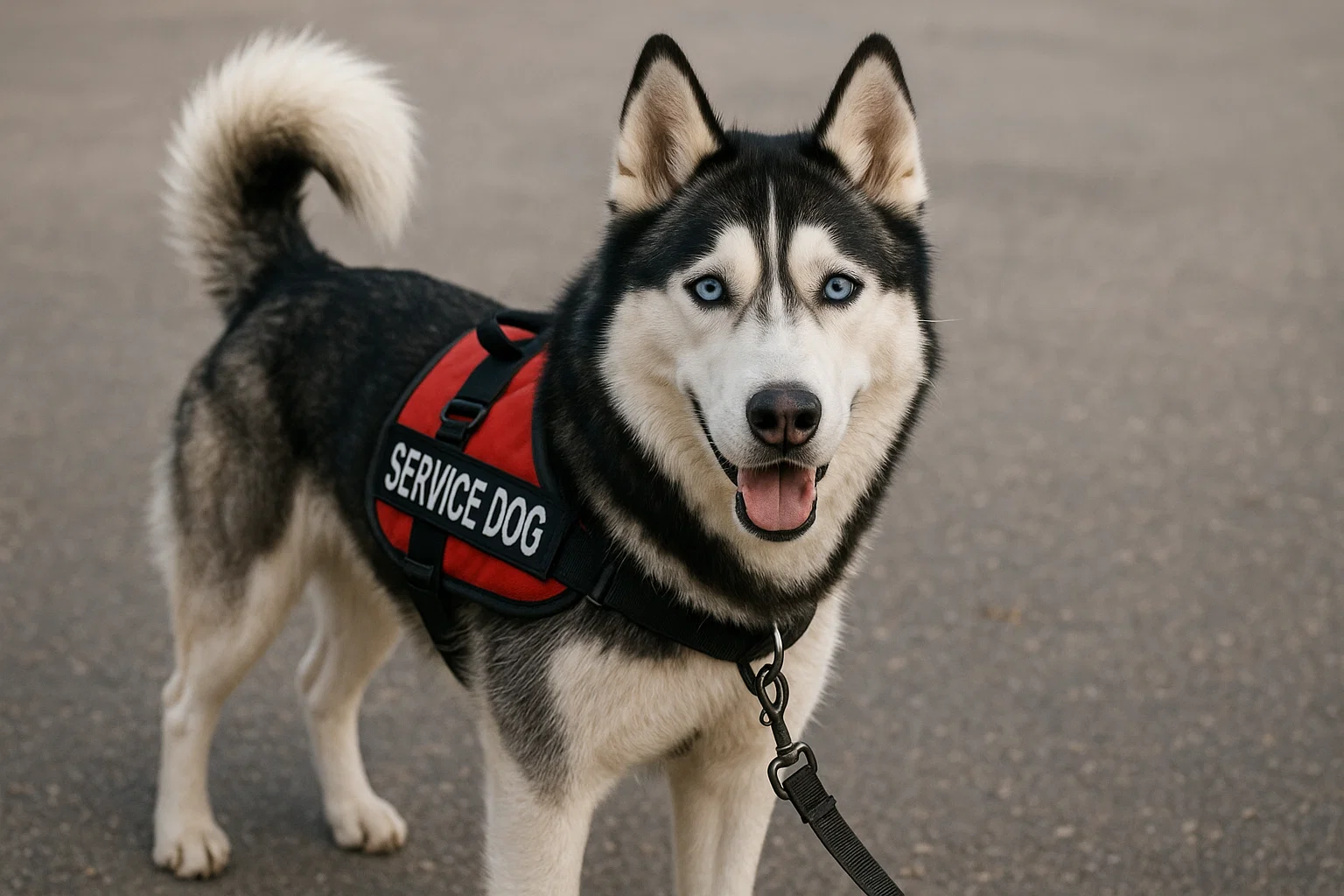Siberian Husky as a Service Dog
Register Your Dog

Siberian Huskies are renowned for their striking appearance and their historical significance as sled dogs in Arctic environments. However, when it comes to using them as service dogs, various factors such as their physical capabilities, temperament, and training needs require careful consideration. This article will delve into the suitability of Siberian Huskies as service dogs, examining their essential traits and roles they might best fit in service work settings.
Siberian Husky Overview
The Siberian Husky is a medium-sized working dog breed that originated in Northeast Asia where the Chukchi people developed them as endurance sled dogs. They are known for their strength, speed, and striking physical attributes. These dogs possess a unique combination of traits that require a deep understanding when considering them for service work.
Physical Characteristics
Siberian Huskies exhibit a balanced and compact body structure that is built for endurance and agility rather than brute strength. They generally weigh between 35 to 60 pounds and stand approximately 20 to 24 inches at the shoulder. Their athletic build is supported by a wolf-like appearance with prick ears and a tail that is often carried over the back in a sickle curve.
- Size and Build: Their medium size makes them unsuitable for certain service roles like mobility assistance where larger breeds are preferred.
- Coat and Climate: They have a dense double coat that provides excellent protection against cold weather. However, in warmer climates, this may lead to overheating, which affects their working endurance.
- Physical Stamina: Known for their stamina, Huskies can handle physically demanding tasks and potentially long working hours.
The combination of their size and special coat conditions challenges their adaptation to other climates and roles that require physical moderation instead of continuous high energy output.
Temperament and Attitude
The temperament of a Siberian Husky is both a strength and a limitation in terms of their use as service dogs. They are known for being affectionate, social, and friendly, often forming close bonds with their human companions.
- Independence: Huskies are notably independent and sometimes stubborn, which can pose challenges in training them for specific tasks where compliance is essential.
- Social Nature: Their friendliness makes them less effective as protective service dogs or watchdogs, although it allows them to interact positively in public settings.
- Prey Drive: Due to their history as working dogs, they can exhibit a high prey drive, which can become problematic in environments with small animals.
The social and independent nature of Huskies usually requires experienced handlers to manage effectively, especially in environments that need consistent behavior.
Types of Service Work
While Siberian Huskies possess a range of capabilities, their suitability for different types of service work varies significantly. The following considers some potential roles and their strengths or limitations in these roles:
- Psychiatric Service Work: Their lively and personable nature allows them to provide emotional support, helping individuals with psychiatric conditions by offering companionship and anxiety relief.
- Search and Rescue: Their innate stamina and ability to traverse challenging terrain make them suitable for roles in search and rescue operations.
- Emotional Support Animals (ESAs): Their affectionate nature and ability to bond with humans easily make them excellent for providing emotional support, especially in therapeutic settings.
Due to their size, exuberant energy levels, and independence, they may not be well-suited for roles requiring direct physical intervention or a high degree of precise task repetition.
Health Considerations
As with many purebred dogs, Siberian Huskies are prone to certain health issues that may affect their efficacy and lifespan in service roles.
- Eye Conditions: They can be susceptible to progressive retinal atrophy and cataracts, which can impact their ability to perform tasks where vision is crucial.
- Hip Dysplasia: Although not as common as in larger breeds, hip dysplasia can still be a concern.
- Allergies and Skin Conditions: Their thick double coats are prone to developing skin conditions if not properly cared for, which may be exacerbated in warm climates.
It’s essential for potential handlers to ensure regular veterinary check-ups and be mindful of these health conditions which might affect their long-term viability in service roles.
Training and Suitability
Training a Siberian Husky as a service dog requires expertise and an understanding of their unique behavioral traits.
- Independence and Intelligence: While they are intelligent, their independent nature can sometimes impede traditional training methods that require a high degree of obedience.
- Consistency and Patience: Training requires consistent reinforcement and patience, given their occasional stubbornness.
- Exercise Needs: Huskies have high exercise requirements and perform best in roles where they can be physically active, making daily physical activity crucial in their training regimen.
Understanding these aspects is vital for anyone considering a Siberian Husky for a service dog role as improper training and insufficient exercise may lead to behavioral problems.
Summary of Siberian Husky
In summary, the Siberian Husky can be suitable for certain service roles under specific circumstances but comes with limitations that require careful attention:
**
- Strengths: Endurance, sociable nature, suitability for high-energy tasks.
- Weaknesses: Stubbornness, high prey drive, suitability for cold climates only, health concerns.
- Ideal Service Roles: Search and rescue, emotional support, certain types of psychiatric service work.
**
The analysis suggests that while Siberian Huskies pose challenges in certain service environments due to their temperament and physical needs, they can excel in roles that align with their natural athleticism and social disposition. However, dedicated training and experienced handling are essential to harness these qualities effectively for service work.











